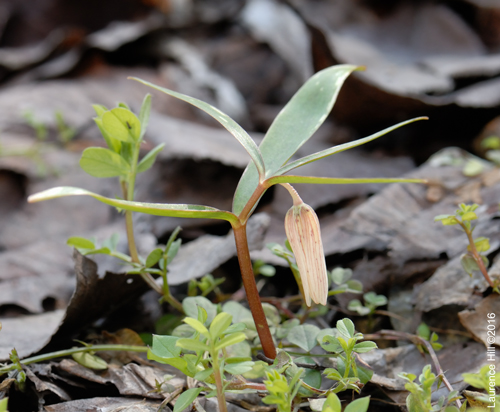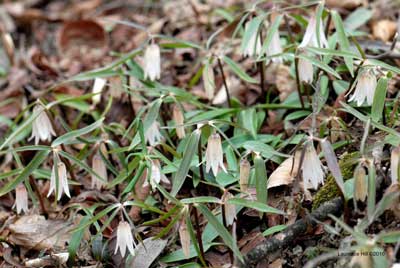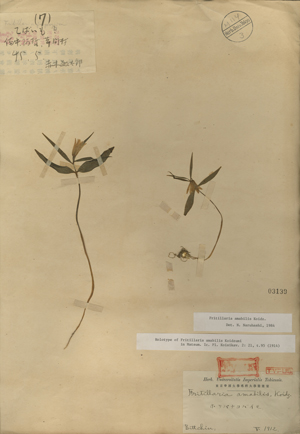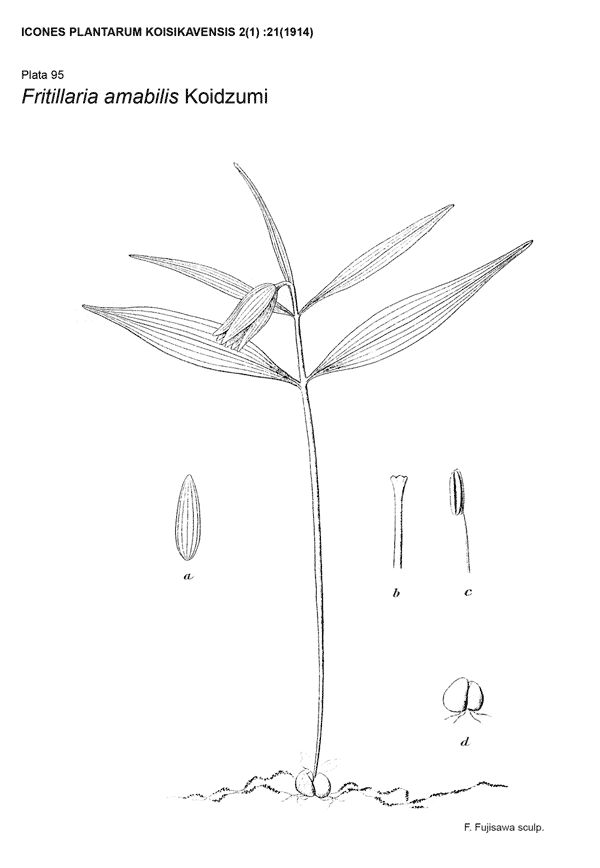Fritillaria amabilis
For almost fifty years only one endemic Fritillaria was recognized from Japan. In April 1912, Toshitaro Akaki collected a narrow-campanulate flowered specimen in Bitchu Province in the foothills of the Chūgoku Mountains, Southern Honshu. The following month Akaki collected two further specimens which were subsequently described as a new species. The young Genichi Koidzumi, who had studied under Jinzo Matsumura at the Imperial University, Tokyo, described and illustrated Akaki’s specimens as F. amabilis or hosabana-kobaimo (slim-flowered little fritillary).

F. amabilis also differs from the broadly-campanulate F. japonica in its small basal nectary and style which is only divided slightly at its apex. In Flora Bitchuensis (1929) the amateur botanist Zensuke Yoshino published a report by Kanjio Maehara of a second location in Kumamoto Prefecture, Kyushu, revealing its much wider distribution. Further narrow-campanulate Fritillaria were subsequently recorded through-out most of Southern Honshu, Kyushu and Shikoku.
In 1964 Dr. Shozo Noda of Osaka Gakuin University published a new chromosome complement for Fritillaria after discovering 11 and not 12 chromosomes in two populations of F. amabilis in Northern Kyushu. Noda with Naohiro Naruhashi subsequently divided the narrow-campanulate flowered Fritillaria into two species. Those from Central Kyushu and Shikoku had the usual 12 chromosomes and blue, not white, anthers so these were named F. shikokiana. Dr. Noda also revealed the presence of achiasmate meiosis in F. amabilis. This form of meiosis had never previously been observed in any plant.

Aid to identification
Within the Fritillaria Japonica Group, F. amabilis is the most variable, even within individual populations. This variation is mostly in leaf colour, markings, and size but also in height and tepal marking. However, within the group only F. amabilis and F. shikokiana have narrow-campanulate flowers, the outcome of their basal nectaries. These two species can be divided by their anther colour, white in F. amabilis and blue in F. shikokiana.
Cultivation
Although Fritillaria amabilis is rare in cultivation it is not difficult to grow. Use equal parts of composted bark, leaf mould and fine grit in terracotta pots. Plunge in an open frame away from direct sunlight. The bulbs must be kept moist at all times. As F. amabilis flowers in late winter hand pollinate to encourage seed set. Seeds should be harvesting as soon as the capsule opens and sown directly.
Fritillaria amabilis Koidz. in Matsumura’s Icones Plantarum Koisikavensis 1914: 21.
Japanese Name: ホソバナコバイモ (Hosabana-kobaimo)
Description
Bulb 10-15 mm in diameter, white twin scaled covered in a thin translucent tunic. Stem 9-25 cm, slender, smooth topped by a whorl of 3 leaves with 2 opposite leaves 1-20 mm below. Leaves green or red, often mottled with white or occasionally with a white longitudinal central strip, all narrow lanceolate or linear, opposite pair 20-70(-95) x (1.4-)3-18 mm, whorled leaves 17-60(-75) x (0.7-)1-8(-11) mm. Pedicel 4-13 mm long, emerging from the middle of the whorl of leaves, green, grey or dark pink, often wrinkled. Flowers nodding narrow-campanulate, white with pink or purple-brown longitudinal veining. Tepals entire 15-20(-26) mm long, inner 3.5-7 mm, outer 3-6mm wide, apex obtuse or pointed often recuved. Nectaries at the base of the tepal, a green dot with pale yellow streak towards the apex, 6-11 mm long. Filament thin, papillose, up to 8 mm long. Anthers narrow oblong to 6 mm long, white. Style papillose, white, to 7 mm long, apex divided 1 mm.
Capsule: green, pendulous, pyramidal with a concave base, valvate, not dry at dispersal, 7-23 mm long, 7-14 mm wide. Seed ovoid, not winged with an elaiosome.
Chromosome Number: 2n = 22, Genome size 1C-value 90.71pg.
Habitat: Below deciduous tree, with Anemone, Corydalis, Chrysosplenium. 100-1000 m
Flowering period: Late February to early April.

Type: Japan, Honshu, Bitchu (West Okayama), Atetsu-gun, Kusama-mura, May 1912, T. Akaki 7 (holotype TI!).

Matsumura’s Icones Plantarum Koisikavensis 1914: 21.
Laurence Hill ©2015
Honshu
Kyushu
![]()


